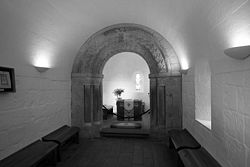- St Margaret's Chapel, Edinburgh
-
 St Margaret's Chapel, Edinburgh
St Margaret's Chapel, Edinburgh
 William Wallace window
William Wallace window
St. Margaret's Chapel, at Edinburgh Castle, is the oldest surviving building in Edinburgh, Scotland. An example of Romanesque architecture, it is a Category A listed building.[1]
Legend had it that St. Margaret worshipped in this small chapel, but recent research indicates that it was built at the beginning of the 12th century by her fourth son who became King David in 1124. The building has been restored and the interior presents much the same appearance as it did when first in use.[citation needed]
The small irregular stone building has some similarity to earlier Scottish and Irish Celtic chapels. The rectangular structure with an internal width of 3 metres (10 ft) has an entrance door at one side near the back of the nave which is 4.87 m (16 ft) long, then a typically Romanesque round chancel arch 1.52 m (5 feet) wide with chevron mouldings decorating the arch above columns on each side leads into an apsed sanctuary 3 m long, with the apse having a radius of 1.52 m. The north wall has been renewed, and the three surviving outer walls are 61 cm (2 ft) thick, as is the chancel wall. Five small round-headed windows and the round arch above the entrance door confirm the Romanesque style.
On the night of 14 March 1314 the Castle was captured by Randolph, Earl of Moray, and in accordance with the policy of King Robert the Bruce he destroyed all the buildings in the Castle, except for the little chapel. On his death bed in 1329, Bruce spoke of the story of Queen Margaret and issued orders for the chapel's repair, with some forty pounds Scots being put aside for that purpose. For many years afterwards the building was known as the "Royal Chapel in the Castle". There is a fairly frequent record of services held in the chapel, though another and larger chapel was also in use within the Castle.
The chapel fell into disuse at the Protestant Reformation, and was used as a gunpowder store in the 16th century and as late as 1845. At that time Sir Daniel Wilson publicised the building, and under his supervision restoration was carried out in 1853 with the support of Queen Victoria. A later proposal by Hippolyte Blanc to enlarge and enrich the chapel was rejected
The stained glass, by Douglas Strachan, was installed in 1922 and illustrates St Andrew, St Columba, St Margaret, St Ninian and William Wallace. In 1929 further work was carried out to bring the chapel back into use, and the restored and refurnished chapel was dedicated on 16 March 1934.
The St. Margaret's Chapel Guild was started in 1942 under the patronage of Her Royal Highness The Princess Margaret and the leadership of Lady Russell. In 1993 as commemoration of the 900th anniversary of the death of St Margaret, Historic Scotland renovated the chapel and St Margaret's Chapel Guild refurbished it with a new altar cloth, ten bench seats, an alms chest, a flower stand, and a display case for a facsimile of the St Margaret's Gospel book. Members of St Margaret's Chapel Guild now have a tradition of ensuring that there are always fresh flowers in the chapel to welcome visitors, whether tourists, those coming to pray or those taking part in services of Holy Baptism or Holy Matrimony.
Location: grid reference NT252735
Open all year except 25/26 December and 1/2 January, ticket admission to castle: 9.30–17.15 April–September, closes an hour earlier other months.
See also
References
- ^ St Margaret's Chapel, Statutory List, Historic Scotland
- Grant, Old and New Edinburgh (1885) p19, ill pp20 and 24
- MacGibbon and Ross, Castellated and Domestic Architecture of Scotland (1887) 445-63, fig402
- Wilson, Memorials of Edinburgh (1891) p167
- RCAHMS, Inventory Edinburgh (1951) pp1–25
- Gifford, McWilliam and Walker, Edinburgh (1984) p91-2
- MacIvor, Edinburgh Castle (1993)
External links
 Media related to St. Margaret's Chapel, Edinburgh at Wikimedia Commons
Media related to St. Margaret's Chapel, Edinburgh at Wikimedia CommonsCoordinates: 55°56′55″N 3°12′00″W / 55.9486638°N 3.2001294°W
Categories:- Category A listed buildings in Scotland
- Listed buildings in Edinburgh
- Edinburgh Castle
- Romanesque architecture in Scotland
- Chapels in Scotland
- 12th-century church buildings
- 12th century in Scotland
- Listed churches in Scotland
- Churches in Edinburgh
Wikimedia Foundation. 2010.

